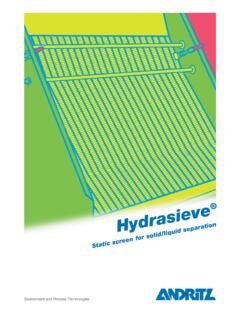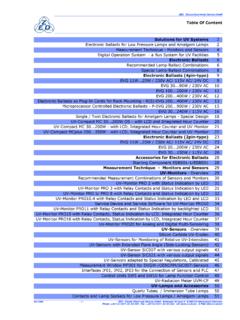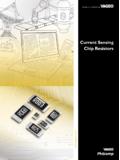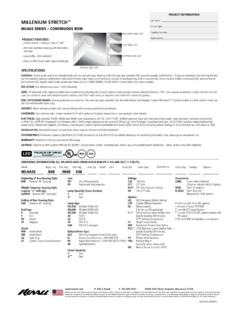Transcription of INTRODUCTION TO UV-OXIDATION FOR ENVIRONMENTAL …
1 INTRODUCTION TO UV-OXIDATION FOR ENVIRONMENTAL CONTAMINANT TREATMENTT rojan has a solution to treat water at virtually every point in its cycle of use to give you confidence in the quality of your water supply. From the moment it is pumped from the ground or drawn from a reservoir, through its various stages of use, to its discharge into our rivers, lakes and oceans, Trojan provides a treatment solution. Our technology is a natural part of a multi-barrier treatment strategy, and offers communities a proven and cost-effective way to protect water supplies from microbial and chemical contamination. Trojan: Providing Water Confidence City not using UVCity using UVOur Interconnected Water SupplyResidential UV disinfectionSources of contaminants in water supplyDrinking water treatment using Trojan for ENVIRONMENTAL Contaminant TreatmentIndustrial plant using Trojan for ENVIRONMENTAL Contaminant TreatmentTraditional chlorine or ozone drinking water treatmentTraditional chlorine wastewater disinfectionTrojanUVPhox.
2 Trojan s optimized UV-Photolysis/ UV-OXIDATION ReactorMicrobiological contaminantChemical contaminant Groundwater extraction/injection well Microbiological Trojan for ENVIRONMENTAL Contaminant TreatmentChemical Groundwater extraction/injection Wastewater treatment for discharge and reuse using Trojan for ENVIRONMENTAL Contaminant TreatmentWhat are ENVIRONMENTAL Contaminants?NDMA: Potential Sources Disinfection of drinking water with chlorine or chloramine Printed circuit board manufacturing Rocket testing/manufacturing Pesticide manufacturing Rubber and tire manufacturing Meat curingKey Contaminants Taste and Odor-Causing Compounds MIB and geosmin Generated by algae and bacteria blooms in rivers, lakes and reservoirs A growing problem due to increasing phosphorus and nitrogen loads on surface waters Causes water to taste and smell earthy and mustyThere is a growing awareness of chemicals in the world s water supply (see the water supply diagram on the opposing flap, right).
3 Recent research has shown that a wide variety of such chemicals exist at trace concentrations in streams, lakes, rivers, and groundwater throughout the world. The term ENVIRONMENTAL contaminants refers to harmful chemicals present in soil, in air, and in water. These compounds may come directly from human sources such as industrial manufacturing, agricultural run-off, and wastewater discharge, or they may originate from natural sources, such as the taste and odor-causing chemicals in water generated by algae and bacteria Growing List of ENVIRONMENTAL Contaminants: N-nitrosodimethylamine (NDMA) Taste and odor-causing compounds ( geosmin and MIB) 1,4-Dioxane Pesticides and herbicides Fuels and fuel additives ( MTBE and BTEX) VOCs ( PCE and TCE) Pharmaceuticals and personal care products (PPCPs) Endocrine disruptor chemicals (EDCs)These compounds can be treated either by ultraviolet (UV) light alone or by UV light in conjunction with an oxidant such as hydrogen UV for ENVIRONMENTAL Contaminants?
4 UV disinfection has been used successfully over the last century to disinfect drinking water and wastewater. That same technology is now being applied to the large-scale ENVIRONMENTAL contaminant treatment (ECT). Simultaneous Disinfection UV, as part of a multi-barrier system, can act to disinfect and destroy contaminants, simultaneously. This is accomplished without the formation of potentially hazardous disinfection by-products, such as the formation of THMs when using chlorine or the formation of bromate when using ozone. Cost-Effective For certain contaminants, UV is the only economical method of treatment. For example, NDMA and 1,4-dioxane cannot be fully treated with membrane technologies (including reverse osmosis), carbon adsorption, or air stripping. Eliminates Residuals UV also has the added advantage of being a destructive technology that breaks down a variety of contaminants into their safe, elemental components.
5 Other treatment technologies merely transfer the contaminant from one phase to another ( air stripping: from water to air) resulting in a potentially hazardous, contaminant-laden residual that requires further treatment or courtesy of Bruce MacleodThe UV-OXIDATION ReactionTrojan s leadership is demonstrated by the patent-pending TrojanUVPhox that is being used to cost-effectively treat NDMA and other contaminants in drinking water and water reuse strong commitment to R&D has fueled Trojan s leadership in the application of UV light to treat ENVIRONMENTAL contaminants. In addition to research in North America, Trojan has formed an international alliance with the PWN Water Supply Company North-Holland (the Netherlands). This research collaboration and the resulting state-of-the-art water treatment installation in Andijk has further developed the use of UV-OXIDATION as a drinking water treatment technology for simultaneous disinfection and destruction of Solutions are Applicable in: Municipal drinking water treatment Water recycling/reclamation/reuse Wastewater treatment Groundwater remediation ( at U.)
6 S. Superfund and other contamination sites) Industrial discharge treatment Industrial process water treatmentTrojan A Commitment to R&DHydrogen peroxide dissolved in waterHydrogen peroxide molecule absorbs one photonHighly energetic and reactive hydroxyl radicals formedHydroxyl radicals decompose the contaminantReaction completed: contaminant converted to carbon dioxide and waterHydroxyl radicals attack contaminantContaminant1346 Photolysis occurs simultaneously572 Drinking Water Solution: CornwallThe City of Cornwall draws its drinking water from the St. Lawrence River in northeastern Ontario, Canada. Frequently, in the late summer and early fall, the water has a musty/earthy taste and smell due to organic compounds produced by summer algae blooms. When the city looked to upgrade its disinfection system to comply with new disinfection rules, it took the opportunity to save taste and odor (T&O) treatment costs by using UV-OXIDATION versus its existing granular activated carbon (GAC) system.
7 The TrojanUVSwift ECT to be installed in 2005-2006 will use UV to disinfect year round, while treating MIB and geosmin during T&O events using UV in combination with hydrogen peroxide. This integrated system will economically provide the dual benefits of disinfection and taste and odor control in treating 22 million gallons of drinking water per day. Equally important, it will do so without forming the disinfection by-product, Reuse Solution: Orange CountyThe Orange County Water District will construct the largest water reuse treatment facility in the world in 2005-2006, the Groundwater Replenishment System (GWRS). The GWRS will employ a highly advanced water treatment facility that will treat wastewater to standards beyond those required for drinking water. The project will treat an average of 70 million gallons per day (mgd) in its first phase, and will ultimately treat up to 130 mgd.
8 The TrojanUVPhox will destroy NDMA and act as the main disinfection system. Solutions for Emerging Needs The patent-pending TrojanUVPhox (UV-Photolysis and UV-OXIDATION ) is a groundbreaking, pressurized UV light reactor that utilizes Trojan s high-output, amalgam UV lamps. Through the extensive use of computational fluid dynamics modeling and other computer simulation tools, it has been optically and hydraulically optimized to provide extremely efficient and cost-effective UV treatment. Its unique design allows for the use of multiple reactors in series, giving the TrojanUVPhox an extremely compact footprint. The TrojanUVSwift ECT employs medium-pressure lamps and sophisticated controls to optimize the treatment of ENVIRONMENTAL contaminants. Its ultra-compact footprint and large flow capacity makes it an excellent reactor for use as part of a multi-barrier system in large, municipal applications (hundreds of millions of gallons per day).
9 In such an application, the TrojanUVSwift ECT destroys contaminants such as taste and odor-causing compounds while providing disinfection of microorganisms such as Cryptosporidium and Proven Leader in UV Solutions for ECT How UV WorksUV-Photolysis is a photochemical reaction that takes place when a contaminant molecule absorbs UV light. The photons break down chemical bonds of the molecule and reduce the potentially harmful chemical to its safe, elemental components (similar to steps 1 through 3 in illustration, left). UV-OXIDATION (illustrated at left) is also a photochemical reaction, but involves the irradiation of hydrogen peroxide with UV light. This creates strongly oxidizing hydroxyl radicals (steps 1 through 3) that oxidize the contaminant, breaking the bonds between the molecules, and reducing the potentially harmful chemical to its safe, elemental components (steps 4 through 7).
10 A TrojanUVSwift ECT system installed at the PWN Water Supply Company in Andijk, the ObjectiveUV DisinfectionSeasonally-Treated ContaminantsMIB and geosminContaminant Treatment Target1-log RemovalPrimary ContaminantNDMAS econdary Contaminantother organicsInfluent Concentration (NDMA)150 pptEffluent Concentration (NDMA)<10 pptLeading the Way from Science to SolutionsCanada and United StatesTelephone: (519) 457-3400 Fax: (519) Printed in Canada. Copyright 2005. Trojan Technologies Inc., London, Ontario, part of this publication may be reproduced, stored in a retrieval system, or transmitted in any form or by any means without the written permission of Trojan Technologies in this publication may be covered by one or more of the following patents: Can. 2,117,004; Can. 2,239,925; US 5,418,370; US RE36,896; US 6,342,188; US 6,564,157; US 6,773,604; US 6,646,269; US 6,659,431; US 6,500,346.












